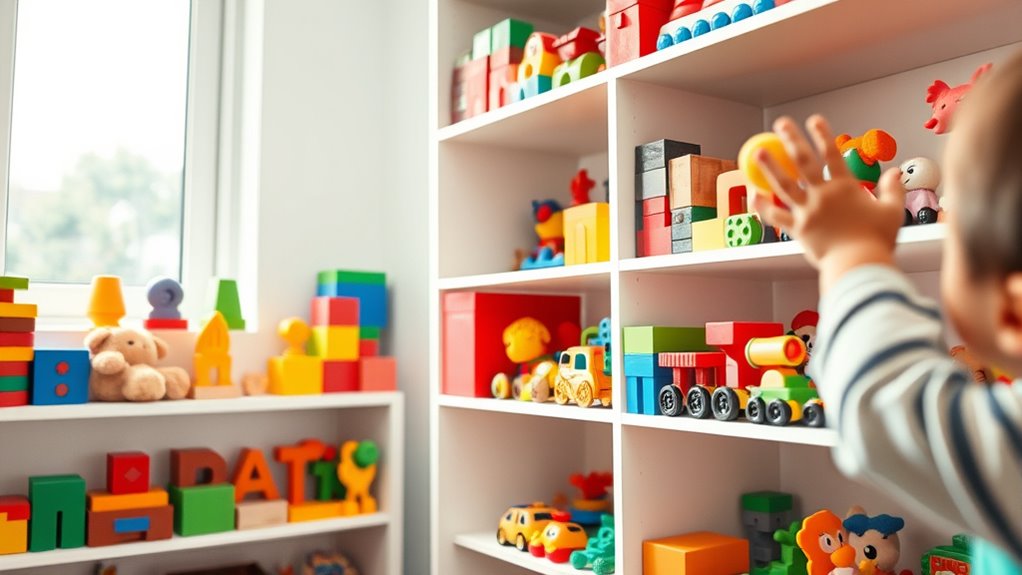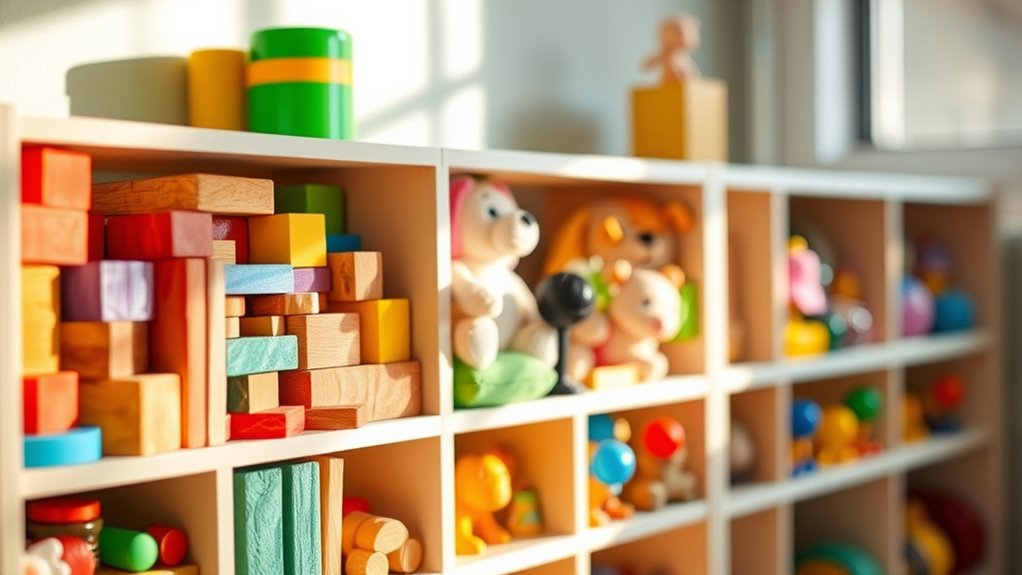Using a toy rotation method helps you keep your child’s play environment fresh and engaging, which boosts their focus and sparks creativity. By organizing toys into manageable groups and rotating them regularly, you minimize clutter and encourage more meaningful play sessions. This approach also fosters appreciation for toys and prevents overstimulation. With better organization and consistent schedules, you can support your child’s development while making cleanup easier. Keep exploring how to implement this effective strategy for even better results.
Key Takeaways
- Organize toys into manageable groups and rotate them on a regular schedule to refresh interest and spark curiosity.
- Limit available toys to encourage focused, meaningful play and reduce overwhelm.
- Involve children in the rotation process to foster acceptance and develop a sense of ownership.
- Use clear storage solutions and designated spaces to keep toys organized and easily accessible.
- Balance variety and consistency to stimulate creativity while maintaining a calm, clutter-free environment.

Have you ever wondered how to keep your child’s toys fresh and engaging? The toy rotation method offers a simple yet powerful way to do just that. Instead of overwhelming your little one with a mountain of toys, you can organize and rotate them regularly. This approach not only refreshes their play environment but also encourages focused, meaningful play. By limiting the number of toys available at any given time, you help your child concentrate better and develop their imagination more deeply. The benefits of rotation extend beyond keeping things interesting; they foster creativity, reduce clutter, and make cleanup easier. When toys are rotated, children tend to appreciate each item more, discovering new ways to play with familiar toys. It can reignite their curiosity and inspire new ideas during playtime. Additionally, choosing the right storage solutions can protect your investment and keep your space organized, especially when considering factors like material durability and accessibility.
However, implementing a toy rotation isn’t without its common challenges. One of the biggest hurdles is maintaining consistency. It’s tempting to forget or lose track of which toys have been rotated, leading to confusion or frustration for both you and your child. Another challenge is ensuring the rotation doesn’t feel too restrictive; children need enough variety to stay stimulated, so striking a balance takes some planning. Additionally, storage can become a headache if you don’t have a dedicated space to keep toys that aren’t currently in use. Without proper organization, toys can get lost or clutter accumulate, defeating the purpose of the method. You might also worry about your child’s attachment to specific toys, fearing they’ll be upset when favorites are temporarily unavailable. But with patience and clear explanations, children often accept the rotation as part of a fun game rather than a punishment.
To get the most out of the toy rotation method, it’s helpful to set a regular schedule—whether weekly or bi-weekly—and stick to it as much as possible. Keep a list or a calendar of which toys are in play and which are stored away. Involving your child in the process can also make the experience more positive; they’ll feel included and learn about organization. Remember, the goal isn’t perfection but creating a more engaging, less cluttered environment that sparks your child’s focus and creativity. Though it takes a bit of effort to set up and maintain, the payoff is worth it: happier, more engaged play and a tidier home. With patience and some planning, you can turn toy rotation into a valuable tool for your child’s development.
Furthermore, understanding how high-quality projectors support sharp, detailed images can help you create an even more engaging play or learning environment at home.
Frequently Asked Questions
How Does Toy Rotation Impact a Child’s Social Skills?
Toy rotation helps improve your child’s social skills by encouraging more playdate opportunities, where they can practice sharing and cooperation. With fewer toys available, your child learns to communicate better and develop emotional skills like patience and empathy. These interactions boost their emotional development, making them more confident in social settings. Plus, the novelty of rotated toys keeps playdates engaging, helping your child build stronger relationships and social understanding over time.
Can Toy Rotation Help Reduce Toy-Related Conflicts Among Siblings?
Imagine a peaceful garden where conflicts fade like wilting weeds. Toy rotation helps reduce sibling battles by limiting access, making sharing boundaries clearer. As toys come and go, kids learn conflict resolution and respect, preventing disputes from erupting like thunderstorms. You create a calm atmosphere where children understand patience and fairness, turning chaos into harmony. With consistent toy changes, you nurture cooperation, transforming rivalry into friendship in your child’s daily life.
What Are the Initial Steps to Implement Toy Rotation Effectively?
To implement toy rotation effectively, start with toy organization by sorting toys into categories. Choose storage solutions like bins or shelves that are easy to access and label them clearly. Then, select a manageable number of toys for the first rotation, storing the rest out of sight. Regularly refresh the toys to keep your child’s interest alive, making sure to involve them in the process for better engagement.
How Often Should Toys Be Rotated for Optimal Benefits?
You should rotate toys weekly to maximize benefits like toy diversity and play variety. This frequency keeps your child engaged, prevents boredom, and encourages creative exploration. By introducing different toys regularly, you help develop their focus and problem-solving skills. Keep track of which toys are in use, and swap them out consistently to maintain excitement and guarantee your child experiences a broad range of play opportunities for ideal growth.
Are There Age-Specific Considerations for Toy Rotation Strategies?
Think of your child’s developmental stages as a garden that needs careful tending. You should tailor toy rotation strategies to their age, providing simple toys during early years to stimulate senses, then introducing more complex ones as they grow. Parental guidance is essential here; it helps you select age-appropriate toys that challenge and engage without overwhelming, fostering healthy development and keeping curiosity alive at every stage.
Conclusion
By embracing the toy rotation method, you transform your child’s playtime into a vibrant garden of curiosity and imagination. This approach keeps their interest fresh and sharpens their focus, much like a well-tended landscape thrives with variety. Remember, consistency is key—watch as their creativity blossoms and attention spans lengthen. With just a little effort, you turn everyday toys into treasures that nurture their growth, making each day an exciting new chapter of discovery.








